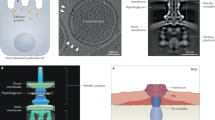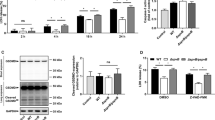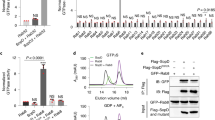Abstract
Microbial infections are most often countered by inflammatory responses that are initiated through the recognition of conserved microbial products by innate immune receptors and result in pathogen expulsion1,2,3,4,5,6. However, inflammation can also lead to pathology. Tissues such as the intestinal epithelium, which are exposed to microbial products, are therefore subject to stringent negative regulatory mechanisms to prevent signalling through innate immune receptors6,7,8,9,10,11. This presents a challenge to the enteric pathogen Salmonella Typhimurium, which requires intestinal inflammation to compete against the resident microbiota and to acquire the nutrients and electron acceptors that sustain its replication12,13. We show here that S. Typhimurium stimulates pro-inflammatory signalling by a unique mechanism initiated by effector proteins that are delivered by its type III protein secretion system. These effectors activate Cdc42 and the p21-activated kinase 1 (PAK1) leading to the recruitment of TNF receptor-associated factor 6 (TRAF6) and mitogen-activated protein kinase kinase kinase 7 (TAK1), and the stimulation of nuclear factor kappa-light-chain-enhancer of activated B cells (NF-κB) inflammatory signalling. The removal of Cdc42, PAK1, TRAF6 or TAK1 prevented S. Typhimurium from stimulating NF-κB signalling in cultured cells. In addition, oral administration of a highly specific PAK inhibitor blocked Salmonella-induced intestinal inflammation and bacterial replication in the mouse intestine, although it resulted in a significant increase in the bacterial loads in systemic tissues. Thus, S. Typhimurium stimulates inflammatory signalling in the intestinal tract by engaging critical downstream signalling components of innate immune receptors. These findings illustrate the unique balance that emerges from host–pathogen co-evolution, in that pathogen-initiated responses that help pathogen replication are also important to prevent pathogen spread to deeper tissues.
This is a preview of subscription content, access via your institution
Access options
Access Nature and 54 other Nature Portfolio journals
Get Nature+, our best-value online-access subscription
$29.99 / 30 days
cancel any time
Subscribe to this journal
Receive 12 digital issues and online access to articles
$119.00 per year
only $9.92 per issue
Buy this article
- Purchase on Springer Link
- Instant access to full article PDF
Prices may be subject to local taxes which are calculated during checkout




Similar content being viewed by others
Data availability
All data generated or analysed during this study are included in this published article (and the Supplementary Information).
References
Nish, S. & Medzhitov, R. Host defense pathways: role of redundancy and compensation in infectious disease phenotypes. Immunity 34, 629–636 (2011).
Medzhitov, R. Recognition of microorganisms and activation of the immune response. Nature 449, 819–826 (2007).
Medzhitov, R. Toll-like receptors and innate immunity. Nat. Rev. Immunol. 1, 135–145 (2001).
Inohara, N. & Nunez, G. Cell death and immunity: NODs: intracellular proteins involved in inflammation and apoptosis. Nat. Rev. Immunol. 3, 371–382 (2003).
Barton, G. & Medzhitov, R. Toll-like receptor signaling pathways. Science 300, 1524–1525 (2003).
Creagh, E. & O’Neill, L. TLRs, NLRs and RLRs: a trinity of pathogen sensors that co-operate in innate immunity. Trends Immunol. 27, 352–357 (2006).
Lee, J., Mo, J., Shen, C., Rucker, A. & Raz, E. Toll-like receptor signaling in intestinal epithelial cells contributes to colonic homoeostasis. Curr. Opin. Gastroenterol. 23, 27–31 (2007).
Kelly, D., Conway, S. & Aminov, R. Commensal gut bacteria: mechanisms of immune modulation. Trends Immunol. 26, 326–333 (2005).
Eckmann, L. Sensor molecules in intestinal innate immunity against bacterial infections. Curr. Opin. Gastroenterol. 22, 95–101 (2006).
Shibolet, O. & Podolsky, D. TLRs in the Gut. IV. Negative regulation of Toll-like receptors and intestinal homeostasis: addition by subtraction. Am. J. Physiol. Gastrointest. Liver Physiol. 292, G1469–G1473 (2007).
Lang, T. & Mansell, A. The negative regulation of Toll-like receptor and associated pathways. Immunol. Cell Biol. 85, 425–434 (2007).
Stecher, B. et al. Salmonella enterica serovar Typhimurium exploits inflammation to compete with the intestinal microbiota. PLoS Biol. 5, 2177–2189 (2007).
Winter, S. et al. Gut inflammation provides a respiratory electron acceptor for Salmonella. Nature 467, 426–429 (2010).
Chen, L. M., Hobbie, S. & Galan, J. E. Requirement of CDC42 for Salmonella-induced cytoskeletal and nuclear responses. Science 274, 2115–2118 (1996).
Hobbie, S., Chen, L. M., Davis, R. & Galán, J. E. Involvement of the mitogen-activated protein kinase pathways in the nuclear responses and cytokine production induced by Salmonella typhimurium in cultured intestinal cells. J. Immunol. 159, 5550–5559 (1997).
Bruno, V. M. et al. Salmonella Typhimurium type III secretion effectors stimulate innate immune responses in cultured epithelial cells. PLoS Pathog. 5, e1000538 (2009).
Hardt, W.-D., Chen, L.-M., Schuebel, K. E., Bustelo, X. R. & Galán, J. E. Salmonella typhimurium encodes an activator of Rho GTPases that induces membrane ruffling and nuclear responses in host cells. Cell 93, 815–826 (1998).
Patel, J. C. & Galan, J. E. Differential activation and function of Rho GTPases during Salmonella-host cell interactions. J. Cell Biol. 175, 453-463 (2006).
Zhou, D., Chen, L. M., Hernandez, L., Shears, S. B. & Galan, J. E. A Salmonella inositol polyphosphatase acts in conjunction with other bacterial effectors to promote host cell actin cytoskeleton rearrangements and bacterial internalization. Mol. Microbiol. 39, 248–259 (2001).
Chen, L. M., Bagrodia, S., Cerione, R. A. & Galan, J. E. Requirement of p21-activated kinase (PAK) for Salmonella typhimurium-induced nuclear responses. J. Exp. Med. 189, 1479–1488 (1999).
Keestra, A. et al. Manipulation of small Rho GTPases is a pathogen-induced process detected by NOD1. Nature 496, 233–237 (2013).
Kobayashi, K. et al. RICK/Rip2/CARDIAK mediates signalling for receptors of the innate and adaptive immune systems. Nature 416, 194–199 (2002).
Chin, A. et al. Involvement of receptor-interacting protein 2 in innate and adaptive immune responses. Nature 416, 190–194 (2002).
Friebel, A. et al. SopE and SopE2 from Salmonella typhimurium activate different sets of RhoGTPases of the host cell. J. Biol. Chem. 276, 34035–34040 (2001).
Lara-Tejero, M. et al. Role of the caspase-1 inflammasome in Salmonella typhimurium pathogenesis. J. Exp. Med. 203, 1407-1412 (2006).
Hannemann, S., Gao, B. & Galán, J. Salmonella modulates host cell gene expression to promote its intracellular growth. PLoS Pathog. 9, e1003668 (2013).
Dammann, K., Khare, V. & Gasche, C. Tracing PAKs from GI inflammation to cancer. Gut 63, 1173–1184 (2014).
Kumar, R., Sanawar, R., Li, X. & Li, F. Structure, biochemistry, and biology of PAK kinases. Gene 605, 20–31 (2017).
Radu, M., Semenova, G., Kosoff, R. & J, C. PAK signalling during the development and progression of cancer. Nat. Rev. Cancer 14, 13–25 (2014).
Dammann, K. et al. PAK1 modulates a PPARγ/NF-κB cascade in intestinal inflammation. Biochim. Biophys. Acta 1853, 2349–2360 (2015).
Lyons, J. et al. Integrated in vivo multiomics analysis identifies p21-activated kinase signaling as a driver of colitis. Sci. Signal. 11, eaan3580 (2018).
Norris, F. A., Wilson, M. P., Wallis, T. S., Galyov, E. E. & Majerus, P. W. SopB, a protein required for virulence of Salmonella dublin, is an inositol phosphate phosphatase. Proc. Natl Acad. Sci. USA 95, 14057–14059 (1998).
Knodler, L., Finlay, B. & O., S.-M. The Salmonella effector protein SopB protects epithelial cells from apoptosis by sustained activation of Akt. J. Biol. Chem. 280, 9058–9064 (2005).
Steele-Mortimer, O. et al. Activation of Akt/protein kinase B in epithelial cells by the Salmonella typhimurium effector sigD. J. Biol. Chem. 275, 37718–37724 (2000).
Hernandez, L. D., Hueffer, K., Wenk, M. R. & Galan, J. E. Salmonella modulates vesicular traffic by altering phosphoinositide metabolism. Science 304, 1805–1807 (2004).
Prudnikova, T., Villamar-Cruz, O., Rawat, S., Cai, K. & Chernoff, J. Effects of p21-activated kinase 1 inhibition on 11q13-amplified ovarian cancer cells. Oncogene 35, 2178–2185 (2016).
Joseph, G. et al. Group I Paks promote skeletal myoblast differentiation in vivo and in vitro. Mol. Cell. Biol. 37, e00222-16 (2017).
Elsherif, L. et al. Potential compensation among group I PAK members in hindlimb ischemia and wound healing. PLoS ONE 9, e112239 (2014).
Rennefahrt, U. et al. Specificity profiling of Pak kinases allows identification of novel phosphorylation sites. J. Biol. Chem. 282, 15667–15678 (2007).
Dolan, B. et al. Rescue of fragile X syndrome phenotypes in Fmr1 KO mice by the small-molecule PAK inhibitor FRAX486. Proc. Natl Acad. Sci. USA 110, 5671–5676 (2013).
Frost, J. et al. Stimulation of NFkappa B activity by multiple signaling pathways requires PAK1. J. Biol. Chem. 275, 19693–19699 (2000).
Walsh, M., Lee, J., Choi, Y. & Ibrahim, M. Tumor necrosis factor receptor- associated factor 6 (TRAF6) regulation of development, function, and homeostasis of the immune system. Immunol. Rev. 266, 72–92 (2015).
Ajibade, A., Wang, H. & Wang, R. Cell type-specific function of TAK1 in innate immune signaling. Trends Immunol. 34, 307–316 (2013).
Shin, Y., Kim, Y. & Kim, J. Protein kinase CK2 phosphorylates and activates p21-activated kinase 1. Mol. Biol. Cell. 24, 2990–2999 (2013).
McDaniel, A. et al. Pak1 regulates multiple c-Kit mediated Ras-MAPK gain-in-function phenotypes in Nf1 +/– mast cells. Blood 112, 4646–4654 (2008).
Barthel, M. et al. Pretreatment of mice with streptomycin provides a Salmonella enterica serovar Typhimurium colitis model that allows analysis of both pathogen and host. Infect. Immun. 71, 2839–2858 (2003).
Sun, H., Kamanova, J., Lara-Tejero, M. & Galán, J. A family of Salmonella type III secretion effector proteins selectively targets the NF-κB signaling pathway to preserve host homeostasis. PLoS Pathog. 12, e1005484 (2016).
Gibson, D. et al. Enzymatic assembly of DNA molecules up to several hundred kilobases. Nat. Methods 6, 343–345 (2009).
Obert, S., O’Connor, R. J., Schmid, S. & Hearing, P. The adenovirus E4-6/7 protein transactivates the E2 promoter by inducing dimerization of a heteromeric E2F complex. Molec. Cell. Biol. 14, 1333–1346 (1994).
Hoiseth, S. K. & Stocker, B. A. Aromatic-dependent Salmonella typhimurium are non-virulent and effective as live vaccines. Nature 291, 238–239 (1981).
Galan, J. E., Ginocchio, C. & Costeas, P. Molecular and functional characterization of the Salmonella invasion gene invA: homology of InvA to members of a new protein family. J. Bacteriol. 174, 4338–4349 (1992).
Galán, J. E. & Curtiss, R. III Expression of Salmonella typhimurium genes required for invasion is regulated by changes in DNA supercoiling. Infect. Immun. 58, 1879–1885 (1990).
Intestinal Epithelial Organoid Culture with IntestiCult™ Organoid Growth Medium (Mouse) Doc. #28223 (STEMCELL Technologies, 2016).
Chang, S., Song, J. & Galán, J. Receptor-mediated sorting of typhoid toxin during its export from Salmonella Typhi-infected cells. Cell Host Microbe 20, 682–689 (2016).
Ran, F. A. et al. Genome engineering using the CRISPR-Cas9 system. Nat. Protoc. 8, 2281-2308 (2013).ð
Galán, J. E. & Curtiss, R. III Cloning and molecular characterization of genes whose products allow Salmonella typhimurium to penetrate tissue culture cells. Proc. Natl Acad. Sci. USA 86, 6383–6387 (1989).
Kamanova, J., Sun, H., Lara-Tejero, M. & Galan, J. E. The Salmonella effector protein SopA modulates innate immune responses by targeting TRIM E3 ligase family members. PLoS Pathog. 12, e1005552 (2016).
Liu, X., Gao, B., Novik, V. & Galan, J. E. Quantitative proteomics of intracellular Campylobacter jejuni reveals metabolic reprogramming. PLoS Pathog. 8, e1002562 (2012).
Perkins, D. N., Pappin, D. J., Creasy, D. M. & Cottrell, J. S. Probability-based protein identification by searching sequence databases using mass spectrometry data. Electrophoresis 20, 3551-3567 (1999).
Acknowledgements
We thank J. Chernoff for providing the PAK1–/– mice and members of the Galán laboratory for careful reading of the manuscript. This work was supported by the National Institute of Allergy and Infectious Diseases grant AI055472 (to J.E.G.).
Author information
Authors and Affiliations
Contributions
H.S. and J.E.G. designed the research and analysed data. H.S., J.K. and M.L.-T. performed the research. H.S. and J.E.G. wrote the manuscript with input from all the authors.
Corresponding author
Ethics declarations
Competing interests
The authors declare no competing interests.
Additional information
Publisher’s note: Springer Nature remains neutral with regard to jurisdictional claims in published maps and institutional affiliations.
Supplementary information
Supplementary Information
Supplementary Figures 1–20, Supplementary Tables 5–7.
Supplementary Table 1
LC–MS/MS analyses of CDC42-interacting proteins in uninfected cells.
Supplementary Table 2
LC–MS/MS analyses of CDC42-interacting proteins in S. Typhimurium infected cells.
Supplementary Table 3
LC-MS/MS analyses of PAK1-interacting proteins in uninfected cells.
Supplementary Table 4
LC–MS/MS analyses of PAK1-interacting proteins in S. Typhimurium-infected cells.
Rights and permissions
About this article
Cite this article
Sun, H., Kamanova, J., Lara-Tejero, M. et al. Salmonella stimulates pro-inflammatory signalling through p21-activated kinases bypassing innate immune receptors. Nat Microbiol 3, 1122–1130 (2018). https://doi.org/10.1038/s41564-018-0246-z
Received:
Accepted:
Published:
Issue Date:
DOI: https://doi.org/10.1038/s41564-018-0246-z
This article is cited by
-
Myeloid-derived grancalcin instigates obesity-induced insulin resistance and metabolic inflammation in male mice
Nature Communications (2024)
-
p21-activated kinase 1 (PAK1) as a therapeutic target for cardiotoxicity
Archives of Toxicology (2022)
-
The Salmonella effector protein SopD targets Rab8 to positively and negatively modulate the inflammatory response
Nature Microbiology (2021)
-
Salmonella Typhimurium and inflammation: a pathogen-centric affair
Nature Reviews Microbiology (2021)
-
Effector-triggered immunity and pathogen sensing in metazoans
Nature Microbiology (2019)



